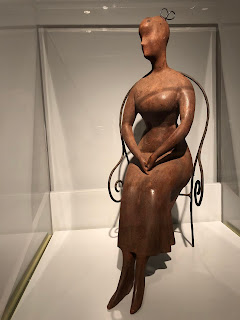Edith Halpert and the Rise of American Art
I just saw the Edith Halpert and the Rise of American Art exhibition at the Jewish Musuem in New York City. It was terrific. I hadn't realized how influential Edith Halpert was. She was the first gallerist to offer installment purchase plans for art. She was successful doing this, even during the Depression. She believed good art should be accessible to everyone, not just the wealthy.
She had unfailingly good taste that ranged from modern to folk art. Throughout her career Halpert supported unknown artists and those whose names and works we now easily recognize, such as Georgia O'Keeffe. She also championed artists rejected by the establishment or vilified at the time, such as Yasuo Kuniyoshi who was interred during WWII for his Japanese heritage.
Here are some photos of the art in the exhibition.
She had unfailingly good taste that ranged from modern to folk art. Throughout her career Halpert supported unknown artists and those whose names and works we now easily recognize, such as Georgia O'Keeffe. She also championed artists rejected by the establishment or vilified at the time, such as Yasuo Kuniyoshi who was interred during WWII for his Japanese heritage.
Here are some photos of the art in the exhibition.
 |
| Elie Nadelman, (1882-1946), Seated Woman, c. 191-1925 Cherrywood and iron Nadelman was in one of Halpert's first exhibitions. She drew inspiration from American folk art. |
 |
| Mabel Dwight (1876-1955), Life Class, 1931 Lithograph Dwight, who was deaf, reflected everyday life with humor and a keen eye. |
 |
| Stuart Davis (1892-1964), Tree and El, 1931 Oil on canvas Davis called himself an "addict of the New England coast" but spent much of his career creating art based on rural and urban subjects. |
 |
| William Stieg (1907-2003), Proud Woman, 1941 Pearwood and rope Already a famous cartoonist for The New Yorker, Stieg premiered his satirical sculptures at Halperts Downtown Gallery. |


Comments